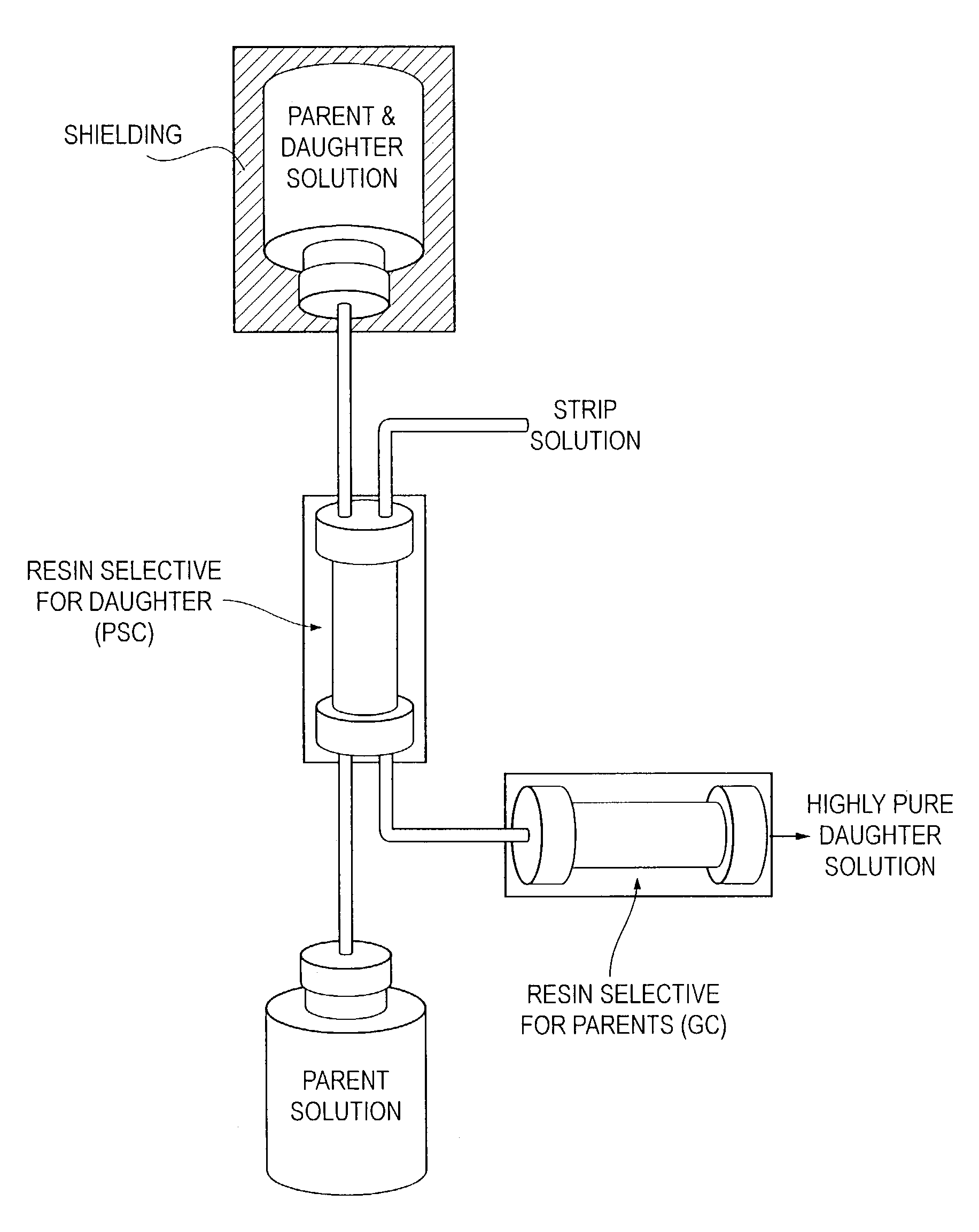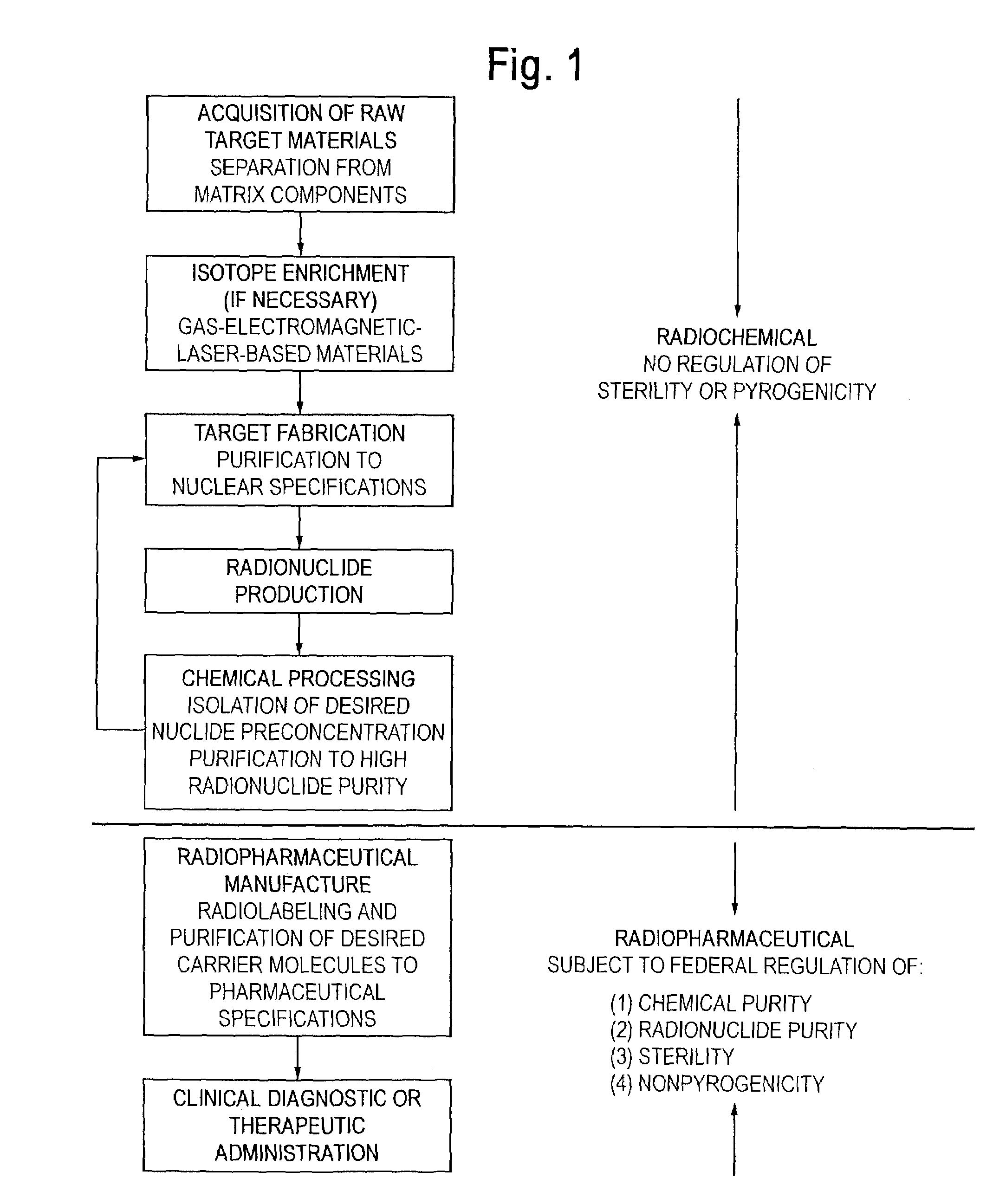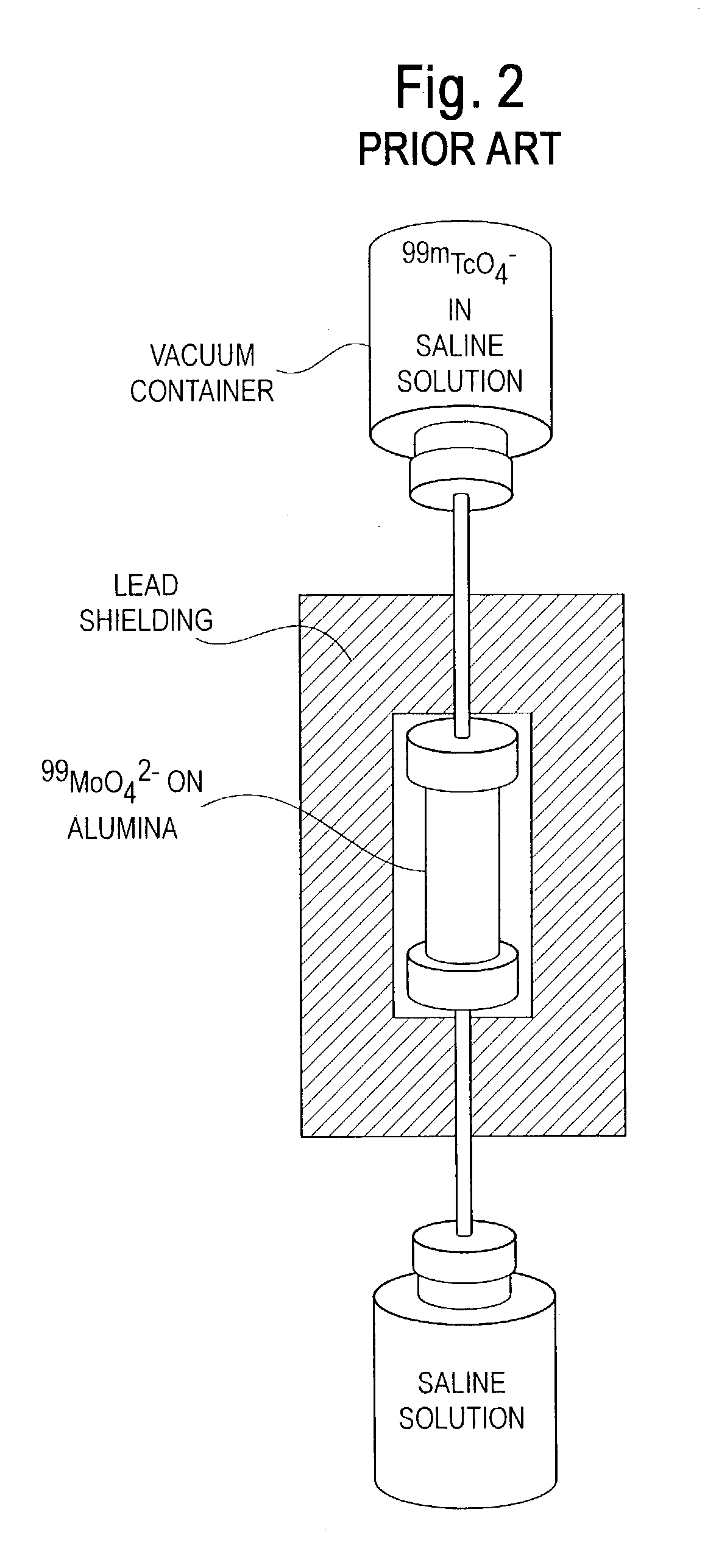In a chemically impure sample, the presence of ionic impurities can interfere with this conjugation reaction.
If sufficient 99mTc, for example, is not coupled to a given biolocalization agent, poorly defined images are obtained due to insufficient
photon density localized at the
target site and / or from an elevated
in vivo background due to a specific distribution in the
blood pool or surrounding tissues.
Regulation of radionuclidic purity stems from the hazards associated with the introduction of long-lived or
high energy radioactive impurities into a patient, especially if the biolocalization and body clearance characteristics of the radioactive impurities are unknown.
Radionuclidic impurities
pose the greatest
threat to patient welfare, and such interferents are the primary focus of clinical
quality control measures that attempt to prevent the administration of harmful and potentially fatal doses of
radiation to the patient.
This generator methodology is not, however, universally acceptable for all radionuclides, especially for those having low
specific activity parent sources or those radionuclides proposed for use in therapeutic
nuclear medicine.
The difficulties of using the conventional generator technology with low
specific activity parent radionuclides; that is, the microquantities of the parent radioisotope present as a mixture with macroquantities of the nonradioactive parent
isotope(s), derive from the need to distribute macroquantities of parent isotopes over a large volume of support so as
not to exceed the
sorbent capacity.
Large chromatographic columns are not practical for nuclear medical applications as the desired daughter
radionuclide is recovered in a large volume of eluate and, as such, is not suitable for clinical use without secondary concentration.
Radionuclides useful in therapeutic nuclear
medicine represent unique challenges to the conventional generator technology and warrant further discussion.
Unfortunately, the LET that makes α- and β1−-emitting nuclides potent cytotoxic agents for
cancer therapy also introduces many unique challenges into the production and purification of these radionuclides for use in medical applications.
Foremost among these challenges is the radiolytic degradation of the support material that occurs when the conventional generator methodology of FIG. 2 is used with high LET radionuclides.
Radiolytic degradation of the generator support material can result in: (a) diminished
chemical purity (e.g.,
radiolysis products from the
support matrix can contaminate the daughter solution); (b) compromised radionuclidic purity (e.g., the support material can release parent radionuclides to the eluate: termed “breakthrough”); (c) diminished yields of daughter radionuclides (e.g., α-
recoil can force the parent radionuclides into stagnant regions of the support making their decay products less accessible to the stripping eluent); (d) decreases in column flow rates (e.g., fragmentation of the
support matrix creates
particulates that increase the pressure drop across the column); and (e) erratic performance (e.g., variability in product purity, nonreproducible yields, fluctuating flow rates, etc.).
Unfortunately, organic-based
ion-exchange resins frequently fail or are severely limited in applications using the conventional generator logic, and typically do so at
radiation levels far below those needed for routine
human use.
By example,
polystyrene-
divinylbenzene copolymer-based cation-exchange resins are used in a generator for the α-emitter 212Bi, but such materials are limited to approximately two week “duty cycles” (i.e., the useful generator lifetime accounting for chemical and physical degradation) for 10–20 mCi generators.
(1992) 43:1093–1101; Horwitz et al., U.S. Pat. No. 5,368,736 (1994); and Ehrhardt et al., U.S. Pat. No. 5,154,897 (1992)] each technology is challenged by scale-up to
Curie levels of production due to problems arising from
radiolysis of the solution medium and the
support matrix.
Unfortunately, the presence of
radiolysis-induced gas pockets adversely affects the chromatographic performance of this conventional generator.
Consequently, the 90Sr was stripped after each
processing run to minimize radiolytic degradation of the support; however, it became increasingly difficult to achieve efficient stripping of 90Sr upon repeated use.
Although the inorganic sorbents represent an improvement with respect to radiolytic stability, such
inorganic materials frequently exhibit poor
ion selectivity, slow partitioning
kinetics, and poorly defined morphologies that inhibit good chromatographic performance.
For more complicated parent daughter relationships, however, several very different
chemical species can appear between the parent and daughter in a given decay chain (e.g., a gas, a tetravalent cation, and a
divalent cation separate 224Ra and 212Bi) and identifying a single inorganic
sorbent capable of retaining all but the desired daughter
radionuclide is difficult.
This concept has several advantages over Al2O3-based generators, but still suffers from the fundamental drawbacks of applying the conventional generator methodology to therapeutic radionuclides.
Although the ZrO(WO4) gel generator for 188Re can permit the use of smaller column volumes than the Al2O3-based generators, the
recovery of valuable isotopically enriched 186W for subsequent
irradiation is still complicated.
Such “improved” radiolytic stability is deceptive, however, as the fundamental chemical reactions underlying the parent / daughter separation still involve molecules constructed from an organic framework that remains susceptible to radiolytic degradation.
Likewise, organic-based chelating moieties have been introduced into engineered inorganic
ion-exchange materials to improve
ion selectivity, but such functionalities continue to suffer the effects of radiolysis.
Initial investigations have relied on
sorption of 225Ra by organic cation-exchange resins, which showed substantial degradation over a short period of time giving reduced yields of 213Bi, poor radionuclidic purity, and unacceptably slow column flow rates.
The silica substrate exhibits greater radiolytic stability than the previously employed organic cation-exchange resins; however, radiolytic damage (i.e., discoloration) was observed surrounding the narrow chromatographic band in which the 225Ac parent is loaded, ultimately leading to breakthrough of the 225Ac parent.
Unfortunately, this batch loading process is awkward and the Dipex® Resin still suffers from radiolytic degradation of the chelating diphosphonic acid diester upon which the separation efficiency relies.
Despite industry preferences for the conventional generator depicted in FIG. 2, the fundamental limitations discussed above are compounded by radiolytic degradation of the support medium when using high levels of the high LET radioactivity useful in therapeutic nuclear
medicine.
The conventional generator is poorly suited, however, to systems involving low
specific activity parents (e.g., the 188W / 188Re generator discussed above) as well as with the high LET radionuclides useful in therapeutic nuclear medicine.
A shift in the fundamental principles governing generator technologies for nuclear medicine, and for therapeutic nuclides specifically, is supported by the fact that the inadvertent administration of the long-lived parents of high LET therapeutic radionuclides would compromise the patient's already fragile health; potentially resulting in death.
Because the conventional generator strategy depicted in FIG. 2 relies on long-term storage of the parent radionuclide on a
solid support that is constantly subjected to high LET radiation, no assurances can be made regarding the chemical and radionuclidic purity of the daughter radionuclide over an approximate 14–60 day generator
duty cycle.
The adverse effects of radiolytic degradation described above
pose enormous challenges in the development of new therapeutic radionuclide generators.
Any damage to the support material of a conventional generator compromises the separation efficiency, potentially resulting in breakthrough of the parent radionuclides and to a potentially fatal
dose of radiation if administered to the patient.
Such a catastrophic event is theoretically prevented by the
quality control measures integrated into nuclear
pharmacy operations, but any lack of safe, predictable generator behavior represents a major liability to the nuclear
pharmacy, hospital, and their respective shareholders.
 Login to View More
Login to View More  Login to View More
Login to View More 


